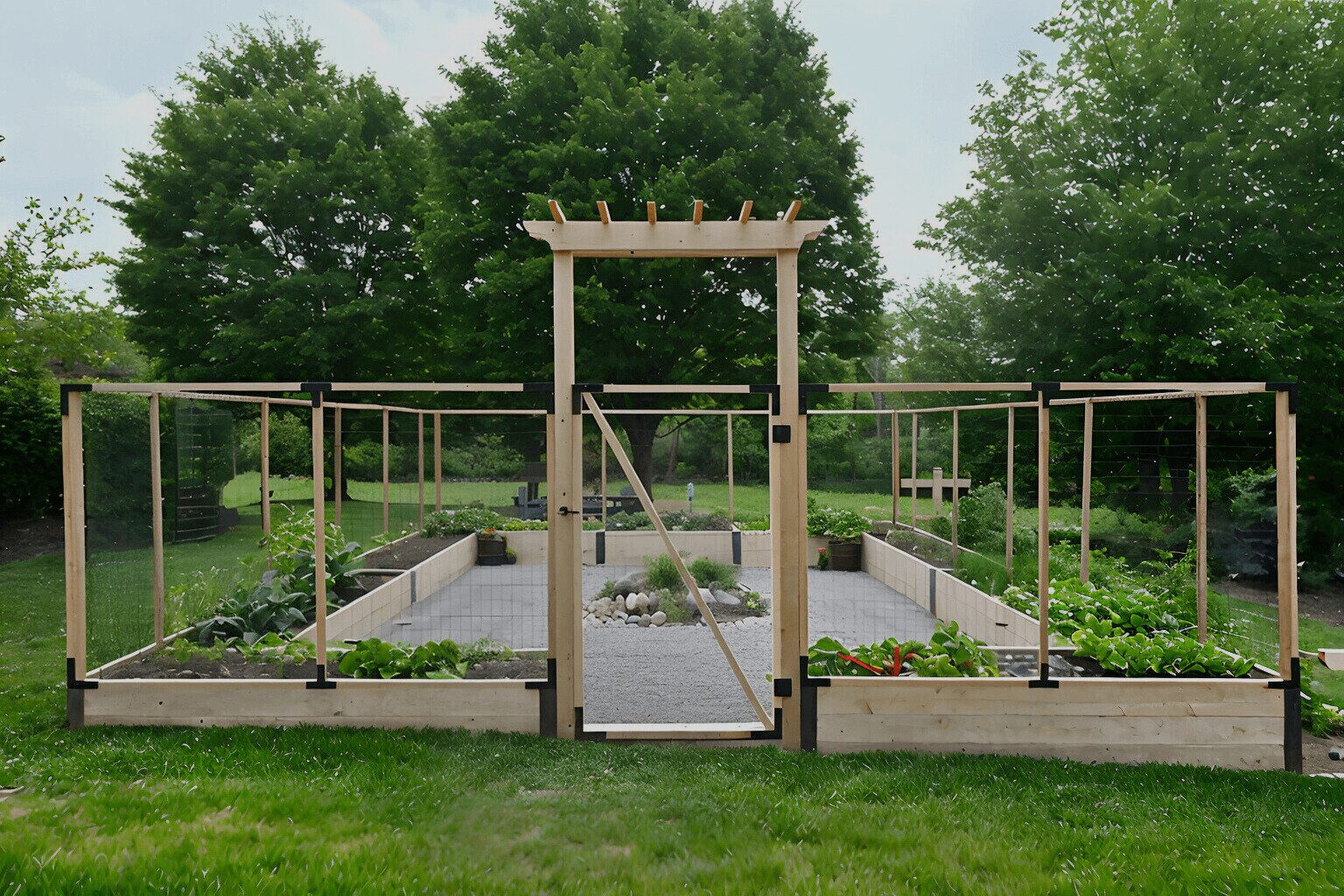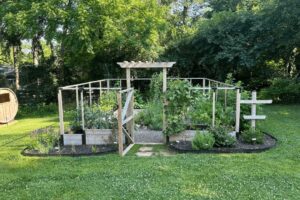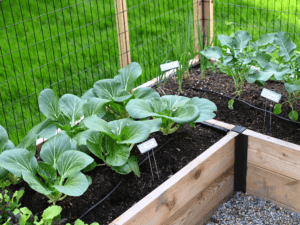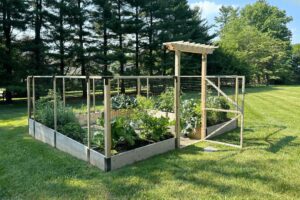
[et_pb_section fb_built=”1″ _builder_version=”4.16″ da_disable_devices=”off|off|off” global_colors_info=”{}” da_is_popup=”off” da_exit_intent=”off” da_has_close=”on” da_alt_close=”off” da_dark_close=”off” da_not_modal=”on” da_is_singular=”off” da_with_loader=”off” da_has_shadow=”on”][et_pb_row _builder_version=”4.16″ background_size=”initial” background_position=”top_left” background_repeat=”repeat” global_colors_info=”{}”][et_pb_column type=”4_4″ _builder_version=”4.16″ custom_padding=”|||” global_colors_info=”{}” custom_padding__hover=”|||”][et_pb_text _builder_version=”4.25.1″ text_text_color=”#000000″ text_font_size=”16px” background_size=”initial” background_position=”top_left” background_repeat=”repeat” global_colors_info=”{}”]
In the past 20 years, more and more people have begun choosing raised beds for their home vegetable gardens. According to data from Ruby Home, “50% of the U.S. gardens are 96 square feet or smaller” (Ruby Home). Raised bed gardens are the perfect solution to grow food in small spaces and for many horticultural reasons, some of which we’ve covered here before.
Today, we will take a look at raised beds’ satisfying intersection of form and function. Raised beds are the right choice for homeowners who want their garden to be an extension of their living space – and want it to be just as neat and enjoyable as their home.
[/et_pb_text][et_pb_image src=”https://backyard-eats.com/wp-content/uploads/2024/02/AI-Garden_Darker_Compressed.jpg” title_text=”AI Garden_Darker_Compressed” _builder_version=”4.25.1″ _module_preset=”default” global_colors_info=”{}”][/et_pb_image][et_pb_text _builder_version=”4.25.1″ text_text_color=”#000000″ text_font_size=”16px” background_size=”initial” background_position=”top_left” background_repeat=”repeat” global_colors_info=”{}”]
First, raised beds provide a clear separation between garden areas and pathways. Unlike in-ground garden beds, which can be difficult to maintain with landscape edging tools, raised beds create clear boundaries and weed-free pathways thanks to layers of gravel and decorative crushed stone. For homeowners who prefer a clean aesthetic, raised beds also provide ample vertical space to grow food: meaning you can enjoy the produce of your tomato or squash plant without tripping over a wandering vine in your yard.
Second, an easy-to-maintain and well-planned raised bed layout becomes an extension of your home’s living space. I like this quote from Stefani Bitter of the Homestead Gardening Collection, a podcast on intuitive cooking from the garden: “Our gardens are for living in.” For 9 months of the year, a raised bed garden space is a wonderful space for curiosity and entertainment. It becomes a place for neighborhood kids to eat their first garden-fresh veggie, for impromptu science lessons, and to experience the unique kind of genuine surprises offered by the magic of growing your own food.
Finally, raised beds grant you the flexibility to locate your garden in the best place for success. During our garden planning process at Backyard Eats, we consider many factors for siting a garden: including proximity to the kitchen and, of course, sun exposure. We give each garden a numeric score based on sun exposure and a combined score for other factors. When your plants thrive with the right conditions and care, it makes having a garden an easy and rewarding experience.
[/et_pb_text][et_pb_image src=”https://backyard-eats.com/wp-content/uploads/2024/02/SpringRaisedBed_BYE-1.png” title_text=”SpringRaisedBed_BYE” _builder_version=”4.25.1″ _module_preset=”default” global_colors_info=”{}”][/et_pb_image][et_pb_text _builder_version=”4.25.1″ text_text_color=”#000000″ text_font_size=”16px” background_size=”initial” background_position=”top_left” background_repeat=”repeat” global_colors_info=”{}”]
We will never build a vegetable garden that is awkward or non-functional: which is why we use raised beds. A custom-built raised bed can be built on a slope, scaled to fit your landscape, and defined with panel fencing for a finished look. Because we fill our raised beds with the ideal organic soil blend rather than relying on existing soil, the growing beds can be placed on any surface or soil without any of the concerns with conventional in-ground gardens. A cedar-framed trellis built into the bed can be placed on the north-most side of the beds to further maximize growing space. To complete the space, a combination of stone pathway materials and metal edging forms a clean, dry path to your patio or kitchen.
The freedom to place a raised bed garden almost anywhere is a key part of what allows us to install vegetable gardens that are set up for success! The control, customization, and clean aesthetic of raised bed gardens are the perfect solution for anyone who wants their garden to feel like a peaceful extension of their living space.
[/et_pb_text][/et_pb_column][/et_pb_row][et_pb_row _builder_version=”4.24.0″ _module_preset=”default” custom_margin=”10px||10px||false|false” custom_margin_tablet=”0px||0px||false|false” custom_margin_phone=”40px||0px||false|false” custom_margin_last_edited=”on|phone” custom_padding=”50px||50px||true|false” locked=”off” global_colors_info=”{}”][et_pb_column type=”4_4″ _builder_version=”4.16″ _module_preset=”default” global_colors_info=”{}”][et_pb_cta button_url=”https://backyard-eats.com/book-a-consultation-step-one/” button_text=”BOOK NOW” _builder_version=”4.25.1″ _module_preset=”default” body_text_color=”#FFFFFF” body_font_size=”16px” body_line_height=”2em” body_link_font=”|700|||on|||#FFFFFF|” body_link_text_color=”#FFFFFF” background_color=”#844B67″ custom_button=”on” button_text_color=”#FFFFFF” button_border_color=”#FFFFFF” button_font=”||||on|||#FFFFFF|” button_use_icon=”off” button_alignment=”left” custom_padding=”|30px|40px|30px|false|false” global_colors_info=”{}”]
Do you want a backyard garden that’s productive, rewarding, and easy to take care of?
At Backyard Eats, we can help make your dream garden a reality! From designing and installing your dream garden to providing ongoing maintenance and education, we promise to help your edible garden succeed.
Book a consultation or contact us today to learn more:
[/et_pb_cta][/et_pb_column][/et_pb_row][/et_pb_section]






